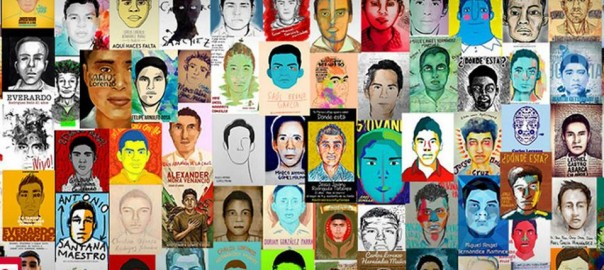On September 26th, in Iguala, Mexico, students from the Escuela Normal Rural Raúl Isidro Burgos were attacked by municipal police and masked men in black. The students, from rural parts of Mexico, attend the Normal Rural School to study to be teachers in the states poorest rural areas like the ones in which they grew up. These students are encouraged to protest and march against corrupt powers and injustice in the spirit of various rural teachers and public political figures of Mexican history, such as Genaro Vázquez and Lucio Cabañas. The students’ public event for that Friday involved stopping a highway to “solicit travel funds for the annual October 2nd march in Mexico City, which commemorates the 1968 massacre of student protestors in the Tlatelolco Plaza by the Partido Revolucionario Institucional (PRI) government of Díaz Ordaz,” (Goldman). The students stopped in the small town of Iguala on Friday, hoping to borrow (as they always have) two buses to make the trip. That day, María de los Ángeles Pineda Villa, the wife of the Mayor of Iguala, José Luis Abarca Velázquez, and sister of the narco-trafficking gang-leader of Guerreros Unidos, was to give a speech in the evening. When the police and masked men arrived on the site, they opened fire two times on the students, killing 6, and injuring more than 20. They forcibly kidnapped 43 of the students, forcing them onto buses, and then leaving the site. Following the attack on and disappearance of the students of Ayotzinapa, Mayor Abarca and his wife Ángeles Pineda Villa disappeared on the run after implications regarding their involvement in the murder of the students of Ayotzinapa in Iguala, they would later be discovered and arrested by federal authorities.
Since the incident, tens of unmarked, unknown mass graves have been unearthed in the search for the 43 missing students. From the graves, authorities have been working to identify severely damaged remnants, destroyed through burning, dismemberment, water damage, and other methods. Countries with advanced technology for identifying remains, such as Argentina and the United States have offered forensic technology to identify the remains of these mass graves. Since then one body of an Ayotzinapa student has turned up. The body of Julio César Fuentes Mondragón was left on the side of a rode with his face torn off and his body thrown as if it were waste. This act is considered a violent threat from the Guerreros Unidos.
Months have passed since the disappearance of the 43 Ayotzinapa students, but very little progress has been made concerning their discovery and the prosecution of those responsible for this act. The 43 students of Ayotzinapa are not the first people to suffer state, national, and gang violence, but they do serve a front-page reminder of the impunity and dark violence that has and continues to plague Mexico today.
This blog acts as a space to inform and explain the history of Mexico about political and social reform. Impunity and terrorism of the state are not new, but a recurring reality. The 43 disappeared students of Ayotzinapa remind the world that this is an ongoing issue and that Mexico is rising. Here we follow and support justice and equality in Mexico.
Jan, 2015
Marcela Dorfsman-Hopkins BM ’15
Aurelia Gómez Unamuno HC
